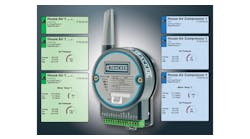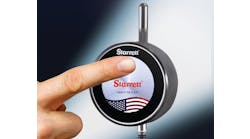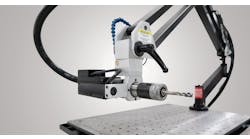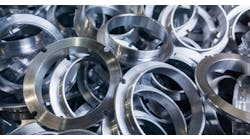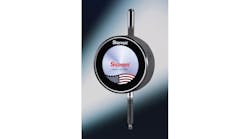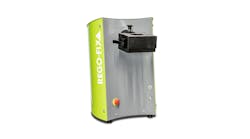Depending on the die, RCBS uses multiple hone sizes as well as varying grit materials and number of strokes to achieve a smooth finish. After the Flex-Hone operation, the surface finish is improved by a factor of eight.
Using manual processes for surface finishing can be more costly than properly automating the operation with the right tools. Repetitive motion tasks and other ergonomic deficiencies not only result in discomfort and injuries, but also in operator fatigue that shrinks productivity and compromises product quality.
In the case of RCBS — which makes ammunition reloading devices as a unit of ATK’s Security & Sporting Group — concerns about such a scenario involving a manual surface finishing operation resulted in a company goal to eliminate the risk of injuries and operator fatigue problems. It also led to significant, productivity and quality gains that were later estimated in the 60-70% range.
RCBS supplies a variety of steel reloading dies for rifles and pistols, typically sold in sets for each caliber to be reloaded.
“We produce hundreds of thousands of these dies every year,” explained Tim Taylor, a RCBS engineer. “So, achieving consistent, high-quality surface finish as well as avoiding worker discomfort became a high priority, and got a lot of attention.”
One of RCBS’ production processes involved hand finishing steel ammunition-reloading die bores, in which workers wrapped emery cloth on rods and polished the internal surface of the dies. It demanded a considerable degree of manual labor on every die.
“The problems with this laborious process included some inconsistencies in the surface finishes,” Taylor recalled, “but this resulted from ergonomic factors, and those were a big, big consideration. Because this was a repetitive-motion job, some workers experienced discomfort or problems with wrists, shoulders and backs.”
According to Taylor, this led RCBS to explore process improvements, including CNC equipment and tools.
A flexible solution
At a trade show Taylor discovered what looked like a possible solution to his surface finishing and ergonomic requirements, a flexible ball-style honing brush made by Brush Research Manufacturing (BRM) that could be tailored to meet its die-bore finishing operation, and also attach to RCBS’ recently acquired CNC equipment.
BRM develops brushing technology for sophisticated manufacturing operations like nuclear energy, aerospace, and computer technology, as well as industrial applications.
The BRM tool, known as the Flex-Hone®, is used widely for de-burring, plateau honing and deglazing. It’s available in many sizes and finishing materials, and consists of a shaft from which extend nylon filaments mounted with hundreds of abrasive grit globules attached. This customizable precision hone is used on materials ranging from soft nonferrous materials to carbide and ceramics to remove even microscopic shards and fragments easily, and it’s highly effective for edge blending, plateau honing, polishing, and chamfer operations.
The Flex-Hone for Firearms line already enjoys a positive reputation for extending the life of firearms. Beyond producing a beautiful finish, the hone removes the microscope “peaks” and “valleys” that can affect the performance and life of the firearm. As a result, many firearm manufacturers are using the Flex-Hone for Firearms in their final finish operations.
In use, the Flex-Hone’s unique, flexible construction makes the tool both self-centering and self-adjusting to compensate for any wear. In accordance with the abrasive type and grit size, precise surface finishes ranging from mirror finishes to cross-hatching are automatically accomplished.
“After we decided to test the Flex-Hone, BRM gave us some recommendations and basic guidelines,” said Taylor. “I had a spare CNC mill, so I made up a fixture and started trying the process at different speeds and feeds. It took several process changes before we were able to consistently achieve our stringent surface finish requirements.”
BRM developed a series of fine-grit models for die applications in which RCBS used progressively finer grits to achieve their results.
A diamond in the rough
Taylor said that the surface finish of the RCBS steel dies is sub-micron (roughness value) when they come off the machine. After the Flex-Hone finishing operation, the surface finish is improved by a factor of eight.
“Depending on the die, we use multiple hone sizes as well as varying grit materials and number of strokes,” Taylor said.
With the steel die finishing solution a success, RCBS decided to try the flexible hone solution on its dies that feature a much harder carbide material.
“On those we use a unique Flex-Hone brush with diamond crystal grit, and basically achieve the same type of results in terms of automation and finish,” Taylor said. “The finish looks like a mirror when we’re done.”
Weighting the results
RCBS discovered that that flexible ball-style hones made by Brush Research Manufacturing could be tailored to meets its die bore finishing requirements and also to attach its recently acquired CNC equipments.
Initially, Taylor wrote a very basic honing program for the CNC mill. Once he decided to go online with the process, he wrote a parametric program to automate the process. Essentially, the CNC operator inputs four or five different parameters, e.g., bore length and ID. The CNC performs the necessary calculations, and then selects the corresponding Flex-Hone brush. Based on the input, the CNC also calculates the number of tool strokes, RPM, and so on.
“The new automated process is a real game-changer,” Taylor said. “It is probably 60-70% more efficient than doing it by hand. Also, there was a substantial increase in quality. It is better and faster, but the ergonomic improvement alone – removal of the potential for operator discomfort and injury - would have been enough to justify the new process. For instance, there are no more repetitive motion injuries because there is no more repetitive motion in the polishing. So, that is a 100% improvement.”
